-
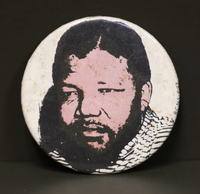 Nelson Mandela, Button.
Nelson Mandela, Button. A button with a sketch of a photo of Nelson Mandela. Nelson Mandella was an anti-apartheid activist in South Africa. After being imprisoned for 27 years due to his African Nationalist ideology, he was released in 1990 and led efforts to end apartheid. He was elected president in 1994 in the country's first fully democratic election.
-
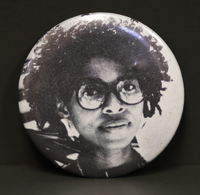 Assata Shakur, Button.
Assata Shakur, Button. A button with a black and white photo of Assata Shakur. She is a political activist and was a member of the Black Liberation Army (BLA), an organization that engaged in armed struggle with the U.S. government. In 1977, she was convicted in a cop-killing case from 1973. Escaping prison in 1979, she has lived in political asylum in Cuba ever since.
-
 H. Rap Brown (Jamil Al-Amin), Button.
H. Rap Brown (Jamil Al-Amin), Button. A button with a black and white photo of H. Rap Brown (Jamil Al-Amin). After organizing in Mississippi during Freedom Summer in 1964, H. Rap Brown became chairman of the Student Nonviolent Coordinating Committee (SNCC) in 1967. He continued SNCC’s adoption of Black Power ideologies which began under his predecessor Stokely Carmichael.
-
 Peace for King-Not War For Bush, Button.
Peace for King-Not War For Bush, Button. A white button with a picture of Dr. Martin Luther King. The text says "Peace for King-Not War for Bush: Bring my father, mother, sister, brother, daughter, cousin, aunt, uncle, niece, nephew, grandfather, grandmother, fiancee, friend & lover home from the Middle East now!"
-
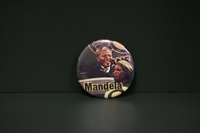 Mandela, Button.
Mandela, Button. A multi-colored button with a picture of Nelson and Winnie Mandela. Nelson Mandella was an anti-apartheid activist in South Africa. After being imprisoned for 27 years due to his African Nationalist ideology, he was released in 1990 and led efforts to end apartheid. He was elected president in 1994 in the country's first fully democratic election.
-
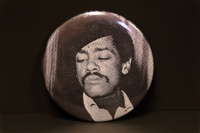 Bobby Seale, Button.
Bobby Seale, Button. A button with a black and white photo of Bobby Seale. The Black Panther Party for Self Defense was founded in 1966 by Bobby Seale and Huey P. Newton in Oakland, California. Rooted in Black Power and Maxist-Leninist ideologies, the Black Panther Party would soon spread with branches all over the United States.
-
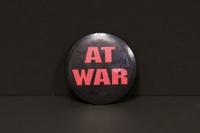 At War, Button.
At War, Button. A black and red button with the slogan "At War."
-
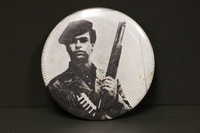 Huey Newton, Button.
Huey Newton, Button. A button with a black and white photo of Huey Newton holding a shotgun. Huey Newton, alongside Bobby Seale, founded the Black Party for Self Defense in Oakland, California in 1966. The Black Panther Party held an ideology of armed self-defense against the oppressive and racist forces of the United States government and police.
-
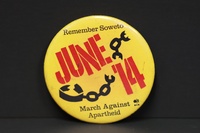 Remember Soweto June 14 March Against Apartheid, Button.
Remember Soweto June 14 March Against Apartheid, Button. A gold button with a drawing of a broken shackle and chain with the text "Remember Soweto June 14 March Against Apartheid." On June 14, 1986, 40,000 people rallied in Central Park in New York City to call on President Ronald Reagan to impose strict economic sanctions on the government of South Africa as a means to ending apartheid in the country.
-
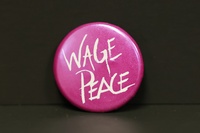 Wage Peace, Button.
Wage Peace, Button. A purple button with text that says "Wage Peace." The phrase was popularized in a speech given by President Dwight D. Eisenhower in 1953 during the Cold War. “Wage Peace” went on to be a rally cry for the anti-war and peace movements, especially during the Vietnam War.
-
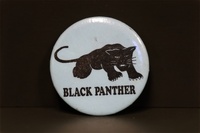 Black Panther Logo, Button.
Black Panther Logo, Button. A blue button with the Black Panther logo and text that says “Black Panther.” The Black Panther Party for Self Defense was founded in 1966 by Bobby Seale and Huey P. Newton in Oakland, California. Rooted in Black Power and Maxist-Leninist ideologies, the Black Panther Party would soon spread with branches all over the United States.
-
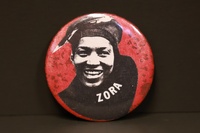 Zora Zora Neal Hurston, Button.
Zora Zora Neal Hurston, Button. A multi-colored button with a photo of Zora Neal Hurston. The text reads “Zora.” Zora Neal Hurston was an author, filmmaker, and researcher, with a focus on African American and Caribbean folklore. Her most famous novel is “Their Eyes Were Watching God” and she wrote over 50 other works, including novels, short stories, plays, and essays.
-
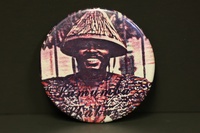 Lumumba Shakur, Button.
Lumumba Shakur, Button. A multi-colored button with a photo of Lumumba Shakur. He was the first husband of Afeni Shakur and the two worked with the Black Panther Party in Harlem, New York, helping Black tenants organize rent strikes for adequate housing. In 1969, they were charged with conspiracy to bomb police buildings along with 19 others, known as the Panther 21.
-
 Power and Knowledge Gained at Medgar Evers College, Button.
Power and Knowledge Gained at Medgar Evers College, Button. A green button that says: "Power and knowledge gained at Medgar Evers College." Text on the bottom of the button also says: "The City University of New York." Medgar Evers College was established in Brooklyn, New York, in 1970 as part of the Central University of New York (CUNY). The college is a public, 4-year, degree granting institution.
-
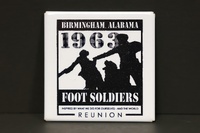 Birmingham, Alabama 1963 Foot Soldiers Reunion, Button.
Birmingham, Alabama 1963 Foot Soldiers Reunion, Button. White square button for the Birmingham, Alabama, 1963 Foot Soldiers Reunion. There is also text on the button that says: "Inspired by what we did for ourselves-and the world." The 1963 Foot Soldiers were children marchers in Birmingham who encountered police resistance in the form of water hoses, attack dogs, and arrests.
-
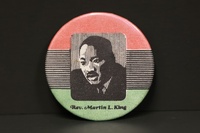 Rev. Martin L. King, Button.
Rev. Martin L. King, Button. A red, green, and black button with an image of Dr. Martin Luther King Jr. Dr. King was a co-founder of the Southern Christian Leadership Conference (SCLC) and remained its leader, and the most prominent leader of the Civil Rights Movement in the South, until his assassination in Memphis in 1968.
-
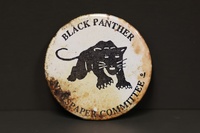 Black Panther Newspaper Committee, Button.
Black Panther Newspaper Committee, Button. A white button with a picture of the Black Panther Party logo. The text says "Black Panther Newspaper Committee." The Black Panther newspaper began as a 4 page newsletter in 1967 by Black Panther Party founders Huey P. Newton and Bobby Seale. The paper went on to express the party’s core ideologies to a large national and international readership.
-
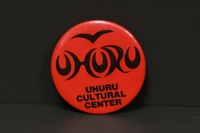 Uhuru Cultural Center, Button.
Uhuru Cultural Center, Button. A red button with the logo for the Uhuru Cultural Center. The Uhuru Movement (from the Swahili word for Freedom”) is an African Internationalist movement founded in 1972 by the African People's Socialist Party (APSP). Uhuru cultural centers and art centers were established around the country.
-
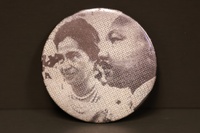 Martin Luther King Jr. With Coretta Scott, Button.
Martin Luther King Jr. With Coretta Scott, Button. A button with a black and white photo of Dr. Martin Luther King Jr. and Coretta Scott. They were married in 1953 until Dr. King’s assassination in 1968. Both were prominent leaders in the Civil Rights Movement in the South. Dr. King was a co-founder of the Southern Christian Leadership Conference (SCLC) and remained its leader until his death.
-
 I Love Africa, Button.
I Love Africa, Button. A white button with a drawing of Africa and the text "I Love Africa."
-
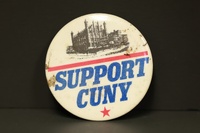 Support CUNY, Button.
Support CUNY, Button. A white button calling for support of CUNY (City University of New York). CUNY was founded in 1960 when several other New York schools were merged into what was initially called the Municipal College System of the City of New York. Throughout the 1960s, CUNY was home to several political and social protests and demonstrations.
-
 John Carlos and Tommy Smith giving the Black Power salute at the 1968 Olympics, Button.
John Carlos and Tommy Smith giving the Black Power salute at the 1968 Olympics, Button. A button with a black and white photo of John Carlos and Tommy Smith giving the Black Power salute at the 1968 Olympics in Mexico City, Mexico after winning bronze and gold medals, respectively, in the 200 meter running event. The salute is considered one of the most overtly political statements in the history of the modern Olympic Games.
-
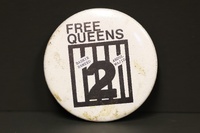 Free Queens 2, Button.
Free Queens 2, Button. A white button in support of freeing the "Queens 2." Their names, Bashir Hameed and Abdul Majid, are listed on the button. The two members of the Black Liberation Army were sentenced to 33 years in prison for the 1981 murder of a New York cop. They were considered political prisoners because of discrepancies in their cases and convictions.
-
 Fannie Lou Hamer, Button.
Fannie Lou Hamer, Button. A red and black button with a picture of Fannie Lou Hamer and her name in print. Ms. Hamer was a renowned leader in Mississippi during the Civil Rights Movement. She worked with the Student Nonviolent Coordinating Committee (SNCC) to organize Freedom Summer in 1964 and was also vice-chair of the Mississippi Freedom Democratic Party.
-
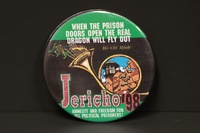 Jericho '98 Amnesty and Freedom for all Political Prisoners, Button.
Jericho '98 Amnesty and Freedom for all Political Prisoners, Button. A black and green button for Jericho '98: Amnesty and freedom for all political prisoners. At the top of the button is a quote from Ho Chi Minh: "When the prison doors open the real dragon will fly out." Jericho 98 was a protest held in Washington, D.C. on March 27, 1998. The 5,000-7,000 attendees called for the release of all political prisoners.
 Nelson Mandela, Button. A button with a sketch of a photo of Nelson Mandela. Nelson Mandella was an anti-apartheid activist in South Africa. After being imprisoned for 27 years due to his African Nationalist ideology, he was released in 1990 and led efforts to end apartheid. He was elected president in 1994 in the country's first fully democratic election.
Nelson Mandela, Button. A button with a sketch of a photo of Nelson Mandela. Nelson Mandella was an anti-apartheid activist in South Africa. After being imprisoned for 27 years due to his African Nationalist ideology, he was released in 1990 and led efforts to end apartheid. He was elected president in 1994 in the country's first fully democratic election. Assata Shakur, Button. A button with a black and white photo of Assata Shakur. She is a political activist and was a member of the Black Liberation Army (BLA), an organization that engaged in armed struggle with the U.S. government. In 1977, she was convicted in a cop-killing case from 1973. Escaping prison in 1979, she has lived in political asylum in Cuba ever since.
Assata Shakur, Button. A button with a black and white photo of Assata Shakur. She is a political activist and was a member of the Black Liberation Army (BLA), an organization that engaged in armed struggle with the U.S. government. In 1977, she was convicted in a cop-killing case from 1973. Escaping prison in 1979, she has lived in political asylum in Cuba ever since. H. Rap Brown (Jamil Al-Amin), Button. A button with a black and white photo of H. Rap Brown (Jamil Al-Amin). After organizing in Mississippi during Freedom Summer in 1964, H. Rap Brown became chairman of the Student Nonviolent Coordinating Committee (SNCC) in 1967. He continued SNCC’s adoption of Black Power ideologies which began under his predecessor Stokely Carmichael.
H. Rap Brown (Jamil Al-Amin), Button. A button with a black and white photo of H. Rap Brown (Jamil Al-Amin). After organizing in Mississippi during Freedom Summer in 1964, H. Rap Brown became chairman of the Student Nonviolent Coordinating Committee (SNCC) in 1967. He continued SNCC’s adoption of Black Power ideologies which began under his predecessor Stokely Carmichael. Peace for King-Not War For Bush, Button. A white button with a picture of Dr. Martin Luther King. The text says "Peace for King-Not War for Bush: Bring my father, mother, sister, brother, daughter, cousin, aunt, uncle, niece, nephew, grandfather, grandmother, fiancee, friend & lover home from the Middle East now!"
Peace for King-Not War For Bush, Button. A white button with a picture of Dr. Martin Luther King. The text says "Peace for King-Not War for Bush: Bring my father, mother, sister, brother, daughter, cousin, aunt, uncle, niece, nephew, grandfather, grandmother, fiancee, friend & lover home from the Middle East now!" Mandela, Button. A multi-colored button with a picture of Nelson and Winnie Mandela. Nelson Mandella was an anti-apartheid activist in South Africa. After being imprisoned for 27 years due to his African Nationalist ideology, he was released in 1990 and led efforts to end apartheid. He was elected president in 1994 in the country's first fully democratic election.
Mandela, Button. A multi-colored button with a picture of Nelson and Winnie Mandela. Nelson Mandella was an anti-apartheid activist in South Africa. After being imprisoned for 27 years due to his African Nationalist ideology, he was released in 1990 and led efforts to end apartheid. He was elected president in 1994 in the country's first fully democratic election. Bobby Seale, Button. A button with a black and white photo of Bobby Seale. The Black Panther Party for Self Defense was founded in 1966 by Bobby Seale and Huey P. Newton in Oakland, California. Rooted in Black Power and Maxist-Leninist ideologies, the Black Panther Party would soon spread with branches all over the United States.
Bobby Seale, Button. A button with a black and white photo of Bobby Seale. The Black Panther Party for Self Defense was founded in 1966 by Bobby Seale and Huey P. Newton in Oakland, California. Rooted in Black Power and Maxist-Leninist ideologies, the Black Panther Party would soon spread with branches all over the United States. At War, Button. A black and red button with the slogan "At War."
At War, Button. A black and red button with the slogan "At War." Huey Newton, Button. A button with a black and white photo of Huey Newton holding a shotgun. Huey Newton, alongside Bobby Seale, founded the Black Party for Self Defense in Oakland, California in 1966. The Black Panther Party held an ideology of armed self-defense against the oppressive and racist forces of the United States government and police.
Huey Newton, Button. A button with a black and white photo of Huey Newton holding a shotgun. Huey Newton, alongside Bobby Seale, founded the Black Party for Self Defense in Oakland, California in 1966. The Black Panther Party held an ideology of armed self-defense against the oppressive and racist forces of the United States government and police. Remember Soweto June 14 March Against Apartheid, Button. A gold button with a drawing of a broken shackle and chain with the text "Remember Soweto June 14 March Against Apartheid." On June 14, 1986, 40,000 people rallied in Central Park in New York City to call on President Ronald Reagan to impose strict economic sanctions on the government of South Africa as a means to ending apartheid in the country.
Remember Soweto June 14 March Against Apartheid, Button. A gold button with a drawing of a broken shackle and chain with the text "Remember Soweto June 14 March Against Apartheid." On June 14, 1986, 40,000 people rallied in Central Park in New York City to call on President Ronald Reagan to impose strict economic sanctions on the government of South Africa as a means to ending apartheid in the country. Wage Peace, Button. A purple button with text that says "Wage Peace." The phrase was popularized in a speech given by President Dwight D. Eisenhower in 1953 during the Cold War. “Wage Peace” went on to be a rally cry for the anti-war and peace movements, especially during the Vietnam War.
Wage Peace, Button. A purple button with text that says "Wage Peace." The phrase was popularized in a speech given by President Dwight D. Eisenhower in 1953 during the Cold War. “Wage Peace” went on to be a rally cry for the anti-war and peace movements, especially during the Vietnam War. Black Panther Logo, Button. A blue button with the Black Panther logo and text that says “Black Panther.” The Black Panther Party for Self Defense was founded in 1966 by Bobby Seale and Huey P. Newton in Oakland, California. Rooted in Black Power and Maxist-Leninist ideologies, the Black Panther Party would soon spread with branches all over the United States.
Black Panther Logo, Button. A blue button with the Black Panther logo and text that says “Black Panther.” The Black Panther Party for Self Defense was founded in 1966 by Bobby Seale and Huey P. Newton in Oakland, California. Rooted in Black Power and Maxist-Leninist ideologies, the Black Panther Party would soon spread with branches all over the United States. Zora Zora Neal Hurston, Button. A multi-colored button with a photo of Zora Neal Hurston. The text reads “Zora.” Zora Neal Hurston was an author, filmmaker, and researcher, with a focus on African American and Caribbean folklore. Her most famous novel is “Their Eyes Were Watching God” and she wrote over 50 other works, including novels, short stories, plays, and essays.
Zora Zora Neal Hurston, Button. A multi-colored button with a photo of Zora Neal Hurston. The text reads “Zora.” Zora Neal Hurston was an author, filmmaker, and researcher, with a focus on African American and Caribbean folklore. Her most famous novel is “Their Eyes Were Watching God” and she wrote over 50 other works, including novels, short stories, plays, and essays. Lumumba Shakur, Button. A multi-colored button with a photo of Lumumba Shakur. He was the first husband of Afeni Shakur and the two worked with the Black Panther Party in Harlem, New York, helping Black tenants organize rent strikes for adequate housing. In 1969, they were charged with conspiracy to bomb police buildings along with 19 others, known as the Panther 21.
Lumumba Shakur, Button. A multi-colored button with a photo of Lumumba Shakur. He was the first husband of Afeni Shakur and the two worked with the Black Panther Party in Harlem, New York, helping Black tenants organize rent strikes for adequate housing. In 1969, they were charged with conspiracy to bomb police buildings along with 19 others, known as the Panther 21. Power and Knowledge Gained at Medgar Evers College, Button. A green button that says: "Power and knowledge gained at Medgar Evers College." Text on the bottom of the button also says: "The City University of New York." Medgar Evers College was established in Brooklyn, New York, in 1970 as part of the Central University of New York (CUNY). The college is a public, 4-year, degree granting institution.
Power and Knowledge Gained at Medgar Evers College, Button. A green button that says: "Power and knowledge gained at Medgar Evers College." Text on the bottom of the button also says: "The City University of New York." Medgar Evers College was established in Brooklyn, New York, in 1970 as part of the Central University of New York (CUNY). The college is a public, 4-year, degree granting institution. Birmingham, Alabama 1963 Foot Soldiers Reunion, Button. White square button for the Birmingham, Alabama, 1963 Foot Soldiers Reunion. There is also text on the button that says: "Inspired by what we did for ourselves-and the world." The 1963 Foot Soldiers were children marchers in Birmingham who encountered police resistance in the form of water hoses, attack dogs, and arrests.
Birmingham, Alabama 1963 Foot Soldiers Reunion, Button. White square button for the Birmingham, Alabama, 1963 Foot Soldiers Reunion. There is also text on the button that says: "Inspired by what we did for ourselves-and the world." The 1963 Foot Soldiers were children marchers in Birmingham who encountered police resistance in the form of water hoses, attack dogs, and arrests. Rev. Martin L. King, Button. A red, green, and black button with an image of Dr. Martin Luther King Jr. Dr. King was a co-founder of the Southern Christian Leadership Conference (SCLC) and remained its leader, and the most prominent leader of the Civil Rights Movement in the South, until his assassination in Memphis in 1968.
Rev. Martin L. King, Button. A red, green, and black button with an image of Dr. Martin Luther King Jr. Dr. King was a co-founder of the Southern Christian Leadership Conference (SCLC) and remained its leader, and the most prominent leader of the Civil Rights Movement in the South, until his assassination in Memphis in 1968. Black Panther Newspaper Committee, Button. A white button with a picture of the Black Panther Party logo. The text says "Black Panther Newspaper Committee." The Black Panther newspaper began as a 4 page newsletter in 1967 by Black Panther Party founders Huey P. Newton and Bobby Seale. The paper went on to express the party’s core ideologies to a large national and international readership.
Black Panther Newspaper Committee, Button. A white button with a picture of the Black Panther Party logo. The text says "Black Panther Newspaper Committee." The Black Panther newspaper began as a 4 page newsletter in 1967 by Black Panther Party founders Huey P. Newton and Bobby Seale. The paper went on to express the party’s core ideologies to a large national and international readership. Uhuru Cultural Center, Button. A red button with the logo for the Uhuru Cultural Center. The Uhuru Movement (from the Swahili word for Freedom”) is an African Internationalist movement founded in 1972 by the African People's Socialist Party (APSP). Uhuru cultural centers and art centers were established around the country.
Uhuru Cultural Center, Button. A red button with the logo for the Uhuru Cultural Center. The Uhuru Movement (from the Swahili word for Freedom”) is an African Internationalist movement founded in 1972 by the African People's Socialist Party (APSP). Uhuru cultural centers and art centers were established around the country. Martin Luther King Jr. With Coretta Scott, Button. A button with a black and white photo of Dr. Martin Luther King Jr. and Coretta Scott. They were married in 1953 until Dr. King’s assassination in 1968. Both were prominent leaders in the Civil Rights Movement in the South. Dr. King was a co-founder of the Southern Christian Leadership Conference (SCLC) and remained its leader until his death.
Martin Luther King Jr. With Coretta Scott, Button. A button with a black and white photo of Dr. Martin Luther King Jr. and Coretta Scott. They were married in 1953 until Dr. King’s assassination in 1968. Both were prominent leaders in the Civil Rights Movement in the South. Dr. King was a co-founder of the Southern Christian Leadership Conference (SCLC) and remained its leader until his death. I Love Africa, Button. A white button with a drawing of Africa and the text "I Love Africa."
I Love Africa, Button. A white button with a drawing of Africa and the text "I Love Africa." Support CUNY, Button. A white button calling for support of CUNY (City University of New York). CUNY was founded in 1960 when several other New York schools were merged into what was initially called the Municipal College System of the City of New York. Throughout the 1960s, CUNY was home to several political and social protests and demonstrations.
Support CUNY, Button. A white button calling for support of CUNY (City University of New York). CUNY was founded in 1960 when several other New York schools were merged into what was initially called the Municipal College System of the City of New York. Throughout the 1960s, CUNY was home to several political and social protests and demonstrations. John Carlos and Tommy Smith giving the Black Power salute at the 1968 Olympics, Button. A button with a black and white photo of John Carlos and Tommy Smith giving the Black Power salute at the 1968 Olympics in Mexico City, Mexico after winning bronze and gold medals, respectively, in the 200 meter running event. The salute is considered one of the most overtly political statements in the history of the modern Olympic Games.
John Carlos and Tommy Smith giving the Black Power salute at the 1968 Olympics, Button. A button with a black and white photo of John Carlos and Tommy Smith giving the Black Power salute at the 1968 Olympics in Mexico City, Mexico after winning bronze and gold medals, respectively, in the 200 meter running event. The salute is considered one of the most overtly political statements in the history of the modern Olympic Games. Free Queens 2, Button. A white button in support of freeing the "Queens 2." Their names, Bashir Hameed and Abdul Majid, are listed on the button. The two members of the Black Liberation Army were sentenced to 33 years in prison for the 1981 murder of a New York cop. They were considered political prisoners because of discrepancies in their cases and convictions.
Free Queens 2, Button. A white button in support of freeing the "Queens 2." Their names, Bashir Hameed and Abdul Majid, are listed on the button. The two members of the Black Liberation Army were sentenced to 33 years in prison for the 1981 murder of a New York cop. They were considered political prisoners because of discrepancies in their cases and convictions. Fannie Lou Hamer, Button. A red and black button with a picture of Fannie Lou Hamer and her name in print. Ms. Hamer was a renowned leader in Mississippi during the Civil Rights Movement. She worked with the Student Nonviolent Coordinating Committee (SNCC) to organize Freedom Summer in 1964 and was also vice-chair of the Mississippi Freedom Democratic Party.
Fannie Lou Hamer, Button. A red and black button with a picture of Fannie Lou Hamer and her name in print. Ms. Hamer was a renowned leader in Mississippi during the Civil Rights Movement. She worked with the Student Nonviolent Coordinating Committee (SNCC) to organize Freedom Summer in 1964 and was also vice-chair of the Mississippi Freedom Democratic Party. Jericho '98 Amnesty and Freedom for all Political Prisoners, Button. A black and green button for Jericho '98: Amnesty and freedom for all political prisoners. At the top of the button is a quote from Ho Chi Minh: "When the prison doors open the real dragon will fly out." Jericho 98 was a protest held in Washington, D.C. on March 27, 1998. The 5,000-7,000 attendees called for the release of all political prisoners.
Jericho '98 Amnesty and Freedom for all Political Prisoners, Button. A black and green button for Jericho '98: Amnesty and freedom for all political prisoners. At the top of the button is a quote from Ho Chi Minh: "When the prison doors open the real dragon will fly out." Jericho 98 was a protest held in Washington, D.C. on March 27, 1998. The 5,000-7,000 attendees called for the release of all political prisoners.